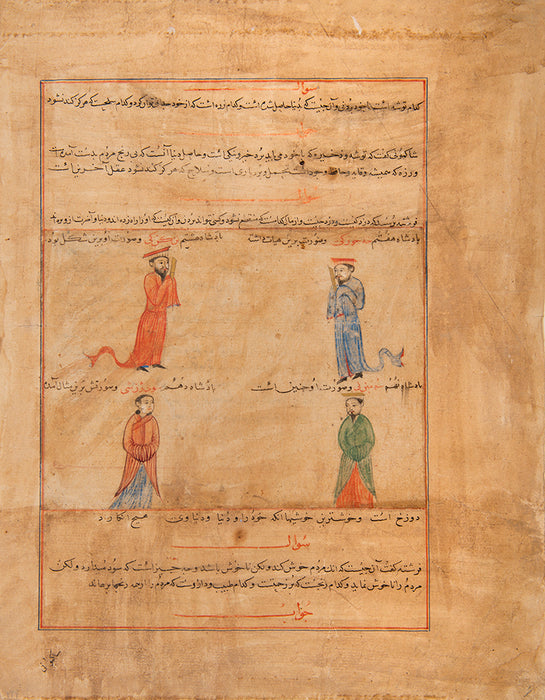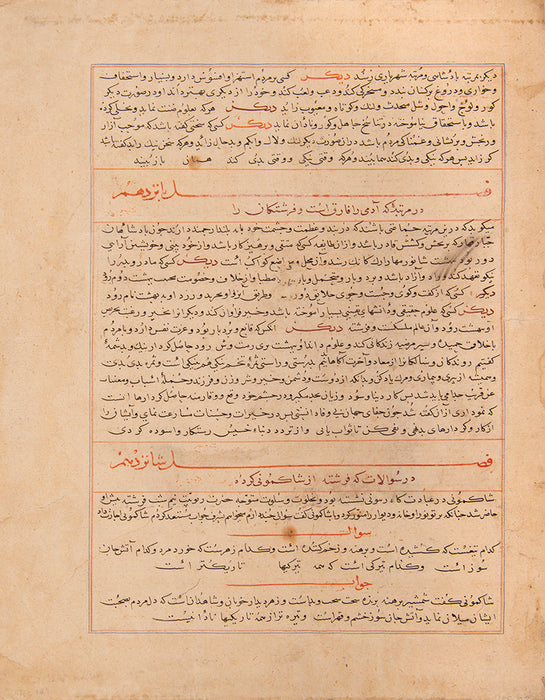
Majma' al-Tawarikh,
commissioned for the Timurid Sultan Shah Rukh,
Timurid Herat, c. 1425-1426 AD.
The Majma al-Tawarikh was written between 1423 and 1426 and is partly based on an earlier work, the Jami al-Tawarikh (Gatherer of Chronicles), ordered by the Ilkhanid ruler Uljaytu and compiled by his minister Rashid al-Din at the Rab'-i Rashidi scriptorium at Tabriz in 1314. The text consists of four parts: a history of the world up to the Arab conquest; a history of the Caliphate until 1258; a history of Persia during the Seljuk and Mongol periods; and the Zubdat al-Tawarikh, which chronicles the lives of Timur and Shah Rukh until 1427. There are two extant copies: a dispersed manuscript formerly in the collection of Emile Tabbagh and Parish Watson, and the other copy, dated AH 829/AD 1425, is in the Topkapi Saray Library, Istanbul (H. 1653). For more information on this manuscript see: S. Canby, Princes, Poets and Paladins: Islamic and Indian Paintings from the Collection of Prince and Princess Sadruddin Aga Khan (London 1998, pp. 28-31); T. Lentz and G. Lowry, Timur and the Princely Vision: Persian Art and Culture in the Fifteenth Century (Los Angeles and Washington 1989, pp. 98-102).
This codex has undergone a series of transformations since its composition in the fifteenth century. At the time of copying, there were a large number of empty spaces within the body of the text left that were never completed by a contemporary artist. These were later completed by a workshop in Iran in the early 20th century, when leaves with 'original' illustrations were cut and pasted to other pages from the same manuscript (presumably to give a better aesthetic quality to these folios), and dispersed by art dealers. The two present leaves both show evidence of this history: the illustration of the four Chinese emperors are contemporary illustrations executed in Shah Rukh's workshop, but the image has been pasted onto an unillustrated folio belonging to the history of Buddha from the same manuscript. The illustrations of the enthroned king in the second folio is modern addition to a folio transcribed in Shah Rukh's library.
Single volume, illuminated manuscript on brown Herati paper, in Farsi, 2 leaves (from 2 different paper stocks), each leaf 423 x 323mm; text in single column, 32 lines fine scribal black naskh, the title of the chapter in large red thuluth and important names in red naskh, text framed within double ruling of red and blue, fol. 1r with illustrations of four Chinese rulers (completed in an early hand), fol. 2r with illustration of enthroned ruler receiving a courtesan (illustration by a later hand, likely painted in Iran c.1900-1925), both illustrations pasted onto the leaves (taken from different pages in the same manuscript), leaves mounted on stubs, first folio washed with some smudges to ink, remains of adhesive to upper margins of both leaves from earlier mounting, pencil inventory number '1960.129' to first leaf and '1960.144' to second; housed in modern burgundy cloth, morocco label to upper cover.
Provenance
Delivery
We offer secure and express delivery on all local and international orders of rare books, maps and prints placed through this website.











